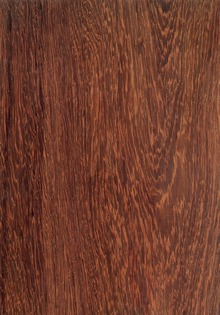Red sandalwood
| Red sandalwood | ||||||||||||
|---|---|---|---|---|---|---|---|---|---|---|---|---|

Red sandalwood ( Pterocarpus santalinus ) |
||||||||||||
| Systematics | ||||||||||||
|
||||||||||||
| Scientific name | ||||||||||||
| Pterocarpus santalinus | ||||||||||||
| ( L. f. ) |
The red sandalwood ( Pterocarpus santalinus ) is a species of the legume family. It is endemic to India and is subject to the Washington Convention on Endangered Species . This species is not related to the sandalwood tree ( Santalum ).
description
The red sandalwood grows as a deciduous tree with heights of about 10-15 meters. The coarse scale bark is brownish-black and partly deeply furrowed. The tree carries a red exudate , cinema.
The leaves are pinnate or pinnate in pairs, with usually three leathery, more or less stalked leaflets . Their shape is egg-shaped to elliptical, rounded with a whole edge. They are bare and rounded or edged to pointed, with a rounded to blunt base and are about 8-18 centimeters long. The nerve is pinnate with a lighter central vein.
Axillary or terminal and racemose inflorescences are formed. The yellow, hermaphrodite and stalked butterfly flowers are about 16-20 mm in size and slightly fragrant. The overgrown, bell-shaped calyx with small tips is fine-haired. The elongated, hairy ovary is superscript and stalked.
The flat, non-opening, brownish wing fruits ( legumes ) are winged in the middle and, including the wing, are 3–8 cm in diameter. Each fruit contains one, rarely two, about 1–1.5 cm large, elongated seeds that are bean-shaped and light brown in color.
The wood is bright red when fresh and darkens to reddish brown to almost black. The bulk density ranges from 580 to 730 kg / m³. The vessels are scattered and the rays are arranged in a single row. Axial parenchyma can also be seen in the cross-section, which is in ligaments and paratracheally (around the vessels).
ecology
Pterocarpus santalinus grows in the vegetation zone of tropical dry forests.
The species blooms in the dry period between late March and late May. The flowers open at night until the early hours of the morning and are taken by bees on moonlit nights, e.g. B. the giant honey bee pollinated. In addition, facultative xenogamy was observed.
Although many flowers are formed, the fructification rate is only very low, which, together with the small area of distribution and intensive use by humans, has led to the species being endangered, see also the section on protection status.
Occurrence
The species is considered endemic to India , the occurrence in other countries, for example China, is not certain. The distribution area in India extends over the southern areas of the Eastern Ghats .
use
Wood
The heartwood of Pterocarpus santalinus is valued primarily for its dark red color and high density. Furniture, carvings and musical instruments are made from it, for example the Japanese shamisen , but also ornaments and sculptures. It is known as red sandalwood, santalwood, or potassium wood
The wood is traded internationally under the names "red sandalwood", "red saunders" or "red sanderswood".
The wood is also used for incense .
medicine
A prepared sandalwood electuary is in the medieval pharmacopoeia Antidotarium Nicolai mentioned. In India the heartwood or extracts from it are used to treat diabetes. It is also said to have anti-inflammatory effects and to treat skin diseases. Some of the bark is also used for medicinal purposes. Red sandalwood also plays a role in incense, usually in the form of wood fragments.
dye
In the past, extracts of the wood were used to dye textiles, the species is one of the so-called insoluble redwoods . However, with the use of synthetic dyes, this dyeing method lost its importance. The main pigment in red sandalwood is santalin . One advantage of dyeing with santalin is that no stain is required to fix the color in the fabric, just a subsequent treatment with an acidic solution. The dye is currently used, for example, to color beverages in the food industry. → Redwood
Protection status
The red sandalwood has been subject to the Washington Convention on Species Protection since 1995 and is listed there in Appendix II. Trading is therefore permitted under certain conditions. In addition, however, there is an import ban of this type into the EU from the country of origin India.
The IUCN has as endangered (the Red sandalwood 1,998 endangered classified).
Web links
- Pterocarpus santalinus at Useful Tropical Plants.
- Pterocarpus santalinus at Pitchandikulam Forest Virtual Herbarium (selection in the menu on the right).
Individual evidence
- ↑ a b c d e f T. Mulliken, P. Crofton: Review of the Status, Harvest, Trade and Management of Seven Asian CITES-listed Medicinal and Aromatic Plant Species. BfN-Skripten 227, 2008, online (PDF; 1.6 MB), accessed on January 13, 2017.
- ↑ a b S. P. Rao, AJS Raju: Pollination ecology of the Red Sanders Pterocarpus santalinus (Fabaceae), an endemic and endangered tree species. In: Current Science. 83 (9), 2002, online at researchgate.net.
- ^ HG Richter, MJ Dallwitz (2000 onwards). Pterocarpus santalinus in Commercial timbers: descriptions, illustrations, identification, and information retrieval. Version: June 25th 2009, Retrieved February 20, 2017.
- ↑ Pterocarpus santalinus in the Germplasm Resources Information Network (GRIN), USDA , ARS , National Genetic Resources Program. National Germplasm Resources Laboratory, Beltsville, Maryland. Retrieved February 20, 2017.
- ↑ Wouter S. van den Berg (ed.): Eene Middelnederlandsche vertaling van het Antidotarium Nicolaï (Ms. 15624–15641, Kon. Bibl. Te Brussel) met the Latin text of the first printed uitgave van het Antidotarium Nicolaï. Edited by Sophie J. van den Berg, EJ Brill, Leiden 1917, p. 152 f.
- ↑ Jürgen Martin: The 'Ulmer Wundarznei'. Introduction - Text - Glossary on a monument to German specialist prose from the 15th century. Königshausen & Neumann, Würzburg 1991 (= Würzburg medical-historical research. Volume 52), ISBN 3-88479-801-4 (also medical dissertation Würzburg 1990), p. 179.
- ↑ KM Benscheidt: Dyes from woody plants - occurrence and economic potential. Diploma thesis, University of Hamburg, 2010.
- ↑ BfN (2016). List of wood species protected in CITES and Regulation (EC) No. 338/97 | VO (EG) 338/97 (status: May 9, 2016), accessed on December 2, 2016.
- ↑ BfN (2013). Current import bans on wood species (as of February 13, 2013), accessed on December 2, 2016.
- ↑ IUCN (2017). The IUCN Red List of Threatened Species (1998), Retrieved February 19, 2017.




